Balsaminaceae - Balsam Family
The Balsaminaceae is a widely-distributed family, with 2 genera containing over 800 species of annual or perennial herbs to sub-shrubs.
Almost all species belong to the genus Impatiens. Many of these plants are stem succulents. The genus Hydrocera is monotypic or contains only a small number of species. |
Impatiens Linnaeus, 1753 (Bizzie Lizzies, Jewelweeds, Touch-me-not)
Name: Impatiens = impatient, referring to manner of seed dispersal
Impatiens includes "Bizzie Lizzies" which are popular houseplants and propagated in vast numbers within the horticultural trade for colourful summer bedding. Many species have soft, succulent stems supporting relatively thin leaves which wither and drop in adverse conditions, but very few species would be welcome in a show of succulent plants. A small number of xerophytic species have tubers (e.g. Impatiens flanaganae Hemsley 1897, Impatiens tuberosa Perrier 1934) or a caudiciform habit (e.g. Impatiens kerriae Craib 1926, Impatiens mirabilis Hooker 1891).
Leaves of Impatiens are generally ovate to lanceolate with serrated margins. Impatiens flowers have five petals and three or five sepals, with the lower sepal elongated into a spur in most species. The four lateral petals of the flowers are always united in pairs, often looking like a single large petal.
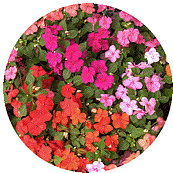 The perennial Impatiens walleriana Hooker fils. 1868 native to East Africa, is one of the best-selling annual bedding plants in the world, but only a handful of the other species are cultivated widely. However, several hybrids and numerous cultivars are available with a wide range of colours and flower forms, including double flowers. Balsams grow well from seed, although young plants are prone to damping off.
The perennial Impatiens walleriana Hooker fils. 1868 native to East Africa, is one of the best-selling annual bedding plants in the world, but only a handful of the other species are cultivated widely. However, several hybrids and numerous cultivars are available with a wide range of colours and flower forms, including double flowers. Balsams grow well from seed, although young plants are prone to damping off.
Some of the hardy balsams have become invasive weeds, with seeds spread explosively when the ripe seed pods burst. Grown in a glasshouse, balsams can spread from pot to pot as "volunteer" seedlings.
Six foot tall stands of Impatiens glandulifera Royle 1834 (Himalayan Balsam) with it's bright pink flowers and explosive seed pods, are often seen along river banks in England and other temperate countries. Mature pods split open explosively at the slightest touch, scattering the seeds. Naturalising invasive balsams may be illegal in some jurisdictions.
|
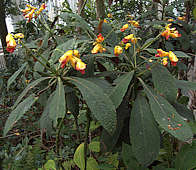 |
Impatiens balansae Hooker fils. 1908
This perennial sub-shrub grows 5 - 6 ft tall. The branching stems carry alternate ovate dark-green leaves with pink veins and serrated margins and curled drip-tips. Large, funnel-shaped bright yellow flowers with a curled yellow spur and pink lips are produced from leaf axils near the stem tips.
Native to Southern Yunnan Province of China and South-East Asia.
|
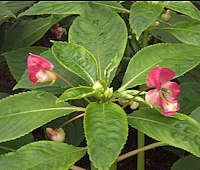 |
Impatiens bisaccata Warburg 1897
An erect branching plant growing 2 - 3 ft tall. The large, alternate leaves, with long petioles and serrated margins, tend to be shed from the lower parts of the stems. The flowers have characteristic transverse markings in their throat and a bisaccate (with two pouches) spur.
Native to Northern to central Madagascar.
|
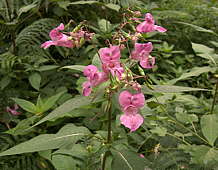 |
Impatiens glandulifera Royle 1834 (Himalayan Balsam, Indian Balsam)
This shrubby plant grows 5 - 6 ft tall with green-red stems supporting glossy green leaves. The white to pink flowers are lightly marked in red or purple and are followed by angular seed pods which when mature, burst explosively at the slightest touch.
Native to India and the Himalayas. The foliage is cut down by frost but regenerates from its dispersed seeds. An invasive weed, but requires damp conditions to flourish.
|
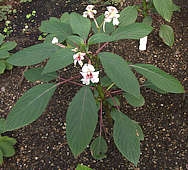 |
Impatiens grandis Heyne 1824
This shrubby plant grows 5 - 6 ft tall. The dark green ovate leaves have pinkish leaf stems and veins and are relatively robust for an Impatiens. The white to pink flowers are marked in red or purple and have a long, curved white spur.
Native to Ceylon and Southern India. A warm growing species, but prefers cooler temperatures for the Winter flowering season.
|
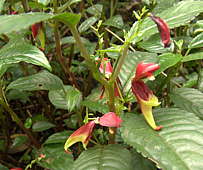 |
Impatiens hians Hooker fils. 1862 Syn. I. bipindensis Gilg 1909
This low-growing understory plant has large dark red and yellowish-green flowers with a broad yellowish-green tail tipped in red.
Native to tropical West Africa including Cameroon, Equatorial Guinea, Gabon and Zaire.
|
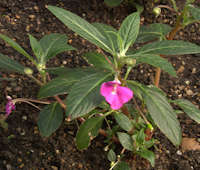 |
Impatiens irvingii Hooker fils. 1868
This semi-aquatic species, growing up to 3 ft tall, is widely distributed across tropical West and central Africa. The succulent red stems are slightly pubescent and carry dark green leaves with reddish veins. The flowers are shocking pink with a long spur.
The leaves of Impatiens irvingii are eaten as a vegetable and used to produce a vegetable salt. They are a traditional remedy for schistosomiasis. However, in its habitat the plant is also associated with the snail that transmits the disease.
|
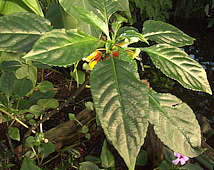 |
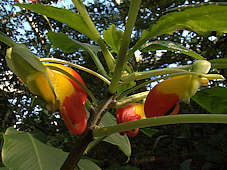 |
|
Above: Impatiens niamniamensis Gilg. 1909 (Congo Cockatoo, Parrot impatiens) Syn. Impatiens congoense
This perennial shrubby plant from tropical East Africa grows 3 - 4 ft tall, with succulent stems supporting a terminal cluster of ovate glossy dark-green leaves with serrated edges. The large 1.5 in, shrimp-shaped blooms are scarlet red and yellow, with a hooked spur and lime green hood and are produced underneath the leaf cluster throughout the year. This tropical plant needs warmth, humidity and shade to grow well and will not tolerate any degree of frost.
|
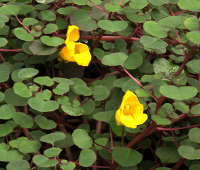 |
Impatiens repens Moon 1824 (Yellow Impatiens, Ceylon Jewelweed)
is a trailing creeper from Ceylon, although extinct or very rare in its native habitat.
The bright yellow flowers up to 4cm long and with a terminal spur are offset by tiny kidney-shaped, green leaves on succulent, self-branching, bright red stems. Photographed growing as ground cover at RBG Kew but also suitable for hanging baskets and containers in semi-shade. |
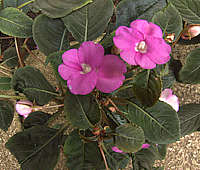 |
Impatiens substipulata Perrier 1934
A rare plant, native to forests of Madagascar at elevations up to 6000 ft.
|
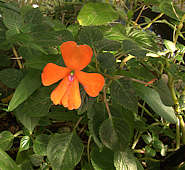 |
Labelled as Impatiens usambarensis from Tanzania, which should have shocking pink flowers.
Looks more like Impatiens hawkeri from New Guinea, or a hybrid with that background.
|

 Families of Succulent Plants
Families of Succulent Plants 















